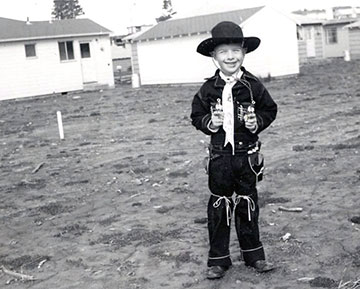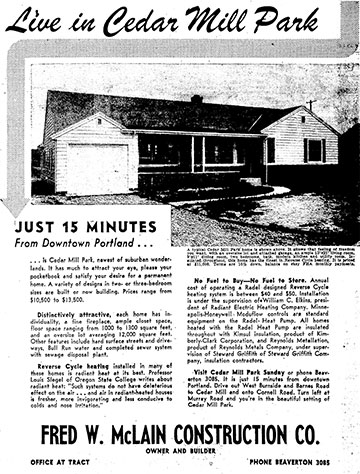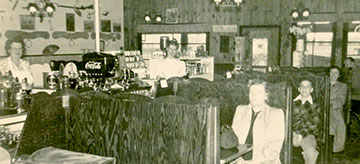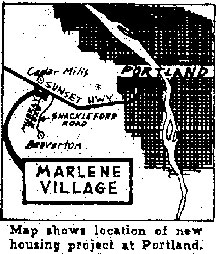 |
Previous Issues |
| Cedar Mill Community Website |
|
Search the Cedar Mill News: Search the Cedar Mill News
|
About The Cedar Mill News |
|
|||||||
| Volume 16, Issue 10 | October 2018 |
||||||
Origins of Marlene and McLain Village
|
||||||||||||||
 |
| Living the suburban dream in McLain Village |
The neighborhoods on either side of Murray Boulevard just south of Sunset Highway are really in an ideal location: close to the highway, surrounded by stores, schools and community gathering centers. One wonders about the story of how they were located here, and the visionaries who made them possible. As urban sprawl seems inevitable, residents here in Cedar Mill and the surrounding areas might take it for granted that we have a lot of conveniences within a short distance. For the McLain and Marlene villages specifically, it is thanks to a certain few individuals, lots of hard labor, and one man with a particular vision. Tom Rohlffs, whose parents bought the second house in Marlene Village, has written an account of how the neighborhoods came to be in his book It Takes a Village to Build a Church. [Ed. Note, all Rohlff quotes are from the book, which is available to view at Village Baptist Church]
 |
| Tom Rohllfs in his back yard shortly after moving in |
Originally, the Tualatin Valley area was the home of the Atfalati native American tribe. Tom writes: “They even lived on Marlene Village. As youngsters, my brother and I found arrowheads in our neighborhood.”1 Pioneers mispronounced the tribe’s name and they became known as the Tualatin.
In order to attract homesteaders to the Oregon Territory (Oregon, Washington, Idaho, and part of Wyoming), the United States Congress enacted the Donation Land Claim (DLC) act, which became law on September 27, 1850. It allowed white Americans to establish homesteads on large tracts of land without regard to legal subdivisions. Every unmarried white male citizen 18 years of age or older could have 320 acres (1.3 km2) of land, and married couples could claim 640 acres (2.6 km2). In the case of a married couple, the husband and wife each owned half of the total grant under their own names. The law was one of the first that allowed married women in the United States to hold property under their own name.
 |
| An ad from a September 1947 Oregonian |
Many of the family names found on the Cedar Mill Donation Land Claims map are familiar: Walker, Cornell, Hall, among others. “Josiah and Mary Hall established a 319-acre claim within the boundaries of what is now Butner, Murray, and Cornell Roads. Their claim included what is now Marlene Village. Village Baptist Church would have bordered their property.”
A man named Fred McLain, a transplant from North Carolina by way of Huntington Beach, California, dreamed of building a community complete with “a shopping center, restaurant, gas station, and a small church in the woods.”4 After the family moved to Hillsboro in 1938, Fred started a construction company with his son Earle. After having built apartments and other rentals in the Hillsboro area, the Commonwealth Bank granted the McLain Construction Company the right to begin building houses in a new subdivision west of Portland called Cedar Mill Park. The going was extremely tough, there was no electricity in the area, no paved streets, and water had to be brought in to make concrete.5 The builders lacked the essential machinery that would’ve made the construction easier. The project was further hampered by high building costs and the absence of a viable route from Portland out to the subdivisions. To get a perspective on travel times, transporting crops from Hillsboro to Portland would take two days.
 |
| Inside the Chuck Wagon Restaurant, early 1950s |
Fred encountered many difficulties, not the least of which was financial. “To help from going under, he would work all day and then come back and work into the evening loading excess dirt from the construction site of the Sunset Highway. He would get $10 for each dump truck load of dirt. He would use this dirt for fill in his village.”6 1949 finally saw the completion of Sunset Highway, though due to the lack of an overpass and on and off ramps, the intersection at Murray Road was the sight of many fatal accidents.
 |
| You can get anything you want at McLain Village! |
Unfortunately, McLain Construction Company ran out of funds and had to abandon the operation. At that point, other investors were jumping into housing projects. One such entrepreneur, a name known to many in the Portland metro area, was Harry Mittleman. Already an established real estate developer and building contractor, Harry saw an opportunity to build his “dream” village on the east side of Murray Road. Tom Rohlffs remembers “Bud and Mary Olson bought the model. We bought the second house next door for $8,500. The homes in McLain Village, west of Murray Rd., were on average $10,500. Marlene Village homes had three designs, all at the same price. He named the streets after his children, and the whole neighborhood was named after his granddaughter Marlene Schnitzer. When we were children, Marlene Village would flood over from Cedar Mill Creek, and some Villagers had to take row boats to their homes. Mittleman was sued five times to clean out our creek.”
 |
Fred McLain’s vision of a community was not yet complete. This would prove to be the key to attracting home buyers to the area. Three years after McLain Village was completed, the McLain Shopping Center was built. “It contained a grocery store, drug store, beauty parlor, variety store, barbershop, dental office, clothing store, and upstairs apartments.”7 The restaurant, built in the pioneer style, was named the Chuck Wagon. “It had prairie schooner wagon wheels around the perimeter… and an authentic covered wagon in the parking lot. The restaurant interior was western style with rifles, guns, yokes, and other pioneer materials decorating the walls.”8 In one photo you can see that Fred repurposed old tractor seats to use as stools around the counter. (The building is now the Greek Village.)
 |
Tom has fond memories of that shopping center: “The Chuck Wagon was the center of all our activity. My Mom sent us up there to get bread or anything else. After school, we would walk across Sunset Highway (no overpass) to the Chuck Wagon restaurant. I would order a ‘graveyard’ or ‘cherry coke’ (5 cents). It was a staple for boyhood snacking after school.” He remembers “The church, Sunset Valley Elementary, strawberry picking, fishing at Bethany Pond and Dairy Creek along Sunset Highway, riding our bikes all over, sports, and the Chuck Wagon was our childhood experiences. Life was good.” Indeed, life is good in Marlene and McLain Village, thanks to forward thinking individuals like Fred McLain and Harry Mittlemann.
![]()
Like us on Facebook for timely updates
Published monthly by Pioneer Marketing & Design
Publisher/Editor:Virginia Bruce
info@cedarmillnews.com
PO Box 91061
Portland, Oregon 97291
© 2013